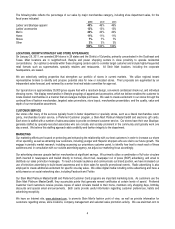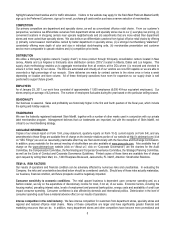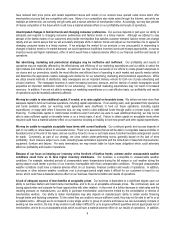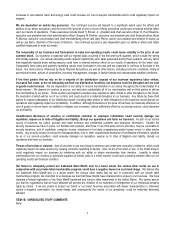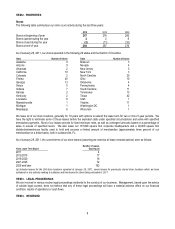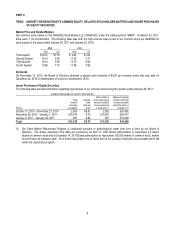Stein Mart 2010 Annual Report Download - page 16
Download and view the complete annual report
Please find page 16 of the 2010 Stein Mart annual report below. You can navigate through the pages in the report by either clicking on the pages listed below, or by using the keyword search tool below to find specific information within the annual report.14
Gross profit as a percent of sales decreased during 2010 primarily due to a 0.6 percent of sales increase in markdowns and negative
leverage on lower sales. Markdowns were higher in 2010 due to the competitive retail environment.
SG&A expenses were $288.6 million or 24.4 percent of net sales for the year ended January 29, 2011 as compared to $314.1 million
or 25.8 percent of net sales for 2009. Excluding pre-tax asset impairment and store closing charges in both years and the $1.2 million
charge associated with changing our physical inventory process in 2010, SG&A expenses decreased $18.7 million to $284.3 million or
24.1 percent of sales from $303.0 million or 24.9 percent of sales for 2009. This decrease reflects a $23.7 million decrease in store
expenses offset by a $3.2 million increase in advertising expenses and a $1.8 million increase in corporate expenses. Store expense
reductions include a $9.0 million decrease in personnel expenses resulting from our new supply chain process, a $9.0 million
decrease in other store operating and depreciation expenses and a $5.7 million decrease due to the elimination of operating costs
from closed stores. Other store operating expenses were lower as a result of continued cost savings initiatives. Depreciation
expense was lower as a result of asset impairment charges taken at the end of fiscal 2009. Advertising spend was higher to increase
our marketing impact.
Asset impairment charges were $7.3 million higher in 2009 due to more store closings and a greater number of stores with projected
cash flows that did not support the carrying value of their long-lived assets which required a write-down of their assets. Store closing
charges were $0.7 million lower this year because there were fewer store closings and this year includes an offsetting $1.2 million
gain on a lease buyout by a landlord for the early termination of a lease.
Other income, net for 2010 increased $11.0 million to $29.4 million from $18.4 million in 2009. During the second quarter of 2010, we
recognized $9.7 million of other income related to cumulative breakage on unused gift and merchandise return cards since the
inception of these programs. Prior to the second quarter of 2010, we had not recognized breakage on card balances pending our
final determination of the interpretation of the escheat laws applicable to our operations and historical redemption patterns. The
remaining increase in other income was from our magazine subscription program and breakage income recognized in the second half
of 2010.
We had a small amount of interest income in 2010 compared to net interest expense in 2009 as a result of having no direct
borrowings since the first quarter of 2009.
The income tax provision for 2010 was favorably impacted by the reversal of the remaining $6 million deferred tax asset valuation
allowance established in 2008. In the fourth quarter of 2010, we were no longer in a cumulative three-year loss position because the
Company’s income in the last two years exceeded the loss incurred in 2008. Excluding this favorable tax adjustment, the effective tax
rate (“ETR”) was 19.6 percent in 2010 compared to 31.5 percent in 2009. The 2010 rate was lower than the federal statutory rate of
35.0 percent due to the impact of favorable changes in book/tax differences on our valuation allowance prior to the year-end reversal
and favorable settlements of state income tax examinations. The 2009 ETR was lower than the federal statutory rate of 35.0 percent
due to the effect of certain book/tax differences on the valuation allowance including a tax accounting method change made in the
third quarter of 2009. We expect our 2011 ETR to be approximately 39.0 percent.
2009 Compared to 2008
Net sales for the year ended January 30, 2010 were $1,219.1 million, down 8.1 percent from $1,326.5 million for 2008. The $107.4
million decrease reflects a $69.7 million decrease in the comparable store group and a $47.9 million decrease in the closed store
group, offset by a $10.2 million increase in the non-comparable store group due to the inclusion of sales for a total of eight stores
opened in 2009 and 2008. The closed store group includes 11 stores closed in 2009 and 10 stores closed in 2008. Comparable
stores sales for 2009 decreased 5.6 percent compared to 2008.
Although sales decreased in 2009, gross profit for the year ended January 30, 2010 increased to $330.4 million or 27.1 percent of net
sales from $294.2 million or 22.2 percent of net sales for 2008. The $36.1 million increase in gross profit reflects a $37.9 million
increase in the comparable store group and a $3.2 million increase in the non-comparable store group, partially offset by a $5.0
million decrease in the closed store group. Gross profit as a percent of sales increased during fiscal 2009 due to a 4.6 percentage
point decrease in markdowns and a 1.1 percentage point increase in markup, offset by a 0.8 percentage point decrease in buying and
occupancy costs. Markdowns were lower in 2009 due to lower inventory levels and lower levels of clearance merchandise.
SG&A expenses were $314.1 million or 25.8 percent of net sales for the year ended January 30, 2010 as compared to $394.8 million
or 29.8 percent of net sales for 2008. SG&A expenses for 2009 include $11.1 million of non-cash pre-tax asset impairment and store
closing charges compared to $25.4 million in 2008. Asset impairment charges were $11.6 million higher last year due to a greater
number of stores with projected cash flows that did not support the carrying value of their long-lived assets. Store closing charges
were $2.7 million higher last year because two closings occurred before the end of the lease term resulting in higher store closing
reserve charges for continuing lease obligations.


